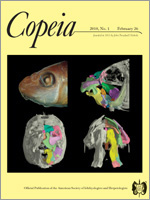Radiotelemetry and genetic markers have enabled herpetologists to test the hypothesis that gene flow is restricted among snake dens (a.k.a. “hibernacula”). In the present study, observations of movement and mating were compared to indirect inferences of gene flow based on genetic data (microsatellite DNA loci) for six neighboring hibernacula of the Timber Rattlesnake (Crotalus horridus) in western St. Louis County, Missouri. Behavioral results were consistent with previous findings for this species, with most individuals exhibiting high fidelity to hibernacula, and males exhibiting larger activity areas than females. Behavioral results also supported several long-standing assumptions: males tended to mate at longer distances from hibernacula than females and random pairing between males and females from different hibernacula could not be rejected. Some gravid females moved considerable distances between locations, but most returned to an area near their own hibernaculum to give birth, and birth distances tended to be shorter than the nearest-neighbor distance between hibernacula. Genetic results indicated that the observed number of heterozygotes did not deviate from Hardy-Weinberg expectations at the level of total sample population, but that a significant heterozygote excess was found within hibernacula. A small but significant proportion of the genetic variance in the total population was due to differences among hibernacula; however, Bayesian clustering algorithms could not sort individuals (or groups of hibernacula) into discrete demes. Results suggest that patterns of genetic differentiation observed among hibernacula of the Timber Rattlesnake are better explained by behavioral and demographic factors resulting in natal philopatry, sex-biased dispersal, and/or a limited number of breeding adults, than by the balance of gene flow and drift, per se.
How to translate text using browser tools
26 February 2010
Effects of Movement and Mating Patterns on Gene Flow among Overwintering Hibernacula of the Timber Rattlesnake (Crotalus horridus)
Corey Devin Anderson
ACCESS THE FULL ARTICLE





